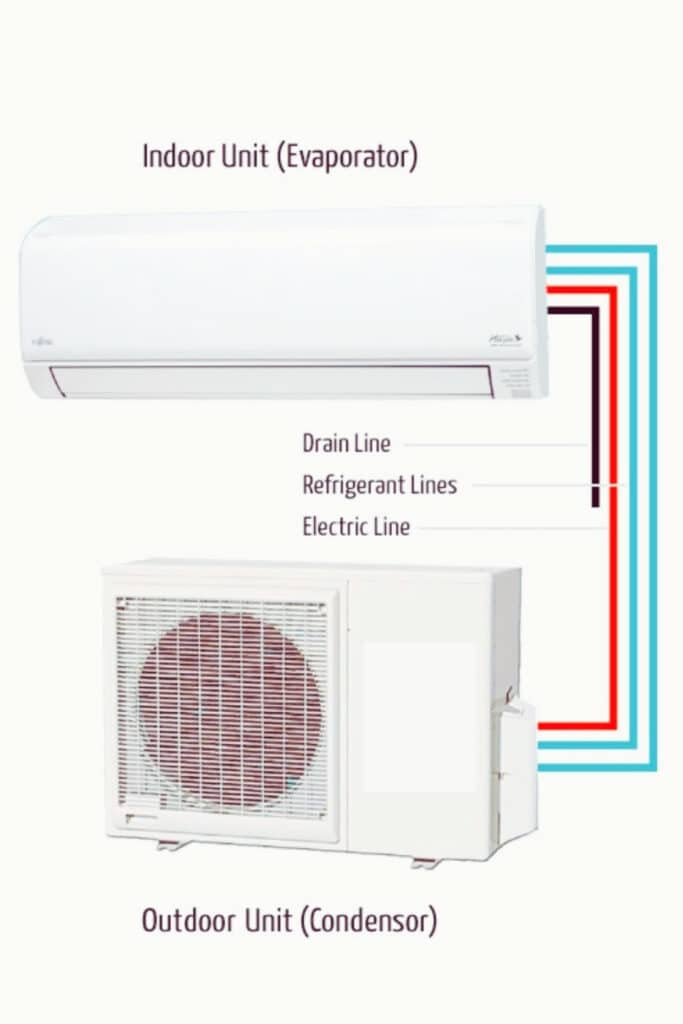Ductless air conditioners are a cost-efficient alternative to central air conditioning. They’re particularly suited to situations where the complicated ductwork needed for central AC would be costly or impossible to install.
A ductless air conditioners system offers several advantages over a traditional window unit or other central air conditioning system. The main advantage is their small size and flexibility to zone, heat, and cool individual rooms. Many of the mini-split models can have up to four indoor air-handling units connected to one outdoor unit. The number of units depends on how much the building or a zone requires heating or cooling. Each of the zones has its own thermostatic control.
How Does A Ductless Air Conditioner Work?
A ductless AC has two main components: an outdoor compressor or condenser unit and one or more indoor air handling units. The indoor units are wall-mounted, and as many as four can be connected to a single system, depending on the cooling needs of your home.

The indoor and outdoor units are connected by a narrow conduit that carries the power cable, refrigerant tubing, suction tubing, and a condensate drain. This conduit runs through a small hole drilled in the wall of the building.
Most ductless air conditioners also feature heat pump technology, which allows you to heat your rooms with the same system in the winter.
Central air conditioning works by pumping refrigerant from the outdoor condenser unit to a single indoor air handler which cools the air. The cold air is then distributed through the house via a network of ducts.
In contrast, in a mini-split air conditioning system, refrigerant is carried from the condenser directly through the conduit to each wall-mounted air handler. A fan draws air across the evaporator coil to cool it and then distributes it directly into the room.
Why Choose A Ductless Air Conditioner?
- Maintain different temperatures in different parts of the building.
Each wall-mounted unit has its own thermostat, which means you can control the temperature in each room or “zone” independently from the others. Central AC cannot offer this kind of flexibility – to lower the temperature in one room; you must lower the temperature in the whole building.
- Easier and cheaper to install than central air.
Even if you have ducts in your building, they will need refitting to accommodate air conditioning. Split AC allows you to avoid ducts altogether, and the only necessary construction is a 3-inch hole necessary for the conduit to pass through the wall. However, installation does require an HVAC technician.
- More energy-efficient than central AC.
Because the air is cooled and released at the wall-mounted handler, the air does not lose coldness as it travels through the building ducts. Duct losses can account for more than 30% of energy consumption for central air conditioning, especially if the ducts are in an unconditioned space such as an attic. Plus, since you can control the temperature in each zone independently, you don’t need to waste money on cooling areas that aren’t occupied.
- Quieter to operate than window or portable air conditioners.
The noisiest parts of any air conditioning system are the compressor fan and condenser motor. With a ductless system, these are isolated outside, so the noise won’t intrude on your indoor environment.
- No need to leave windows open.
When you use a window air conditioner, you must leave the window open, which provides an opportunity for potential intruders. A ductless AC lets you keep windows locked uptight. Plus, you won’t have to store it over the winter and reinstall it each year when it gets home. Installation is one time only.
How To Size A Ductless Air Conditioner?
There’re three main factors to consider when choosing the right size of a split air conditioner: the number of cooling zones, BTUs, and installation type.
As with any air conditioner, you need to know the size of the area you wish to cool in order to select the right size unit. Cooling capacity is measured in BTUs, and a good rule of thumb for split ACs is that you will need 12,000 BTUs for every 500 square feet.
BTUs are units of power, and to calculate the BTU value you need the square footage of your room. Below is a general guide for BTU capacities for a zone.
- 9,000 BTU: 300 – 350 square feet
- 12,000 BTU: 450 – 500 square feet
- 18,000 BTU: 700 – 750 square feet
- 24,000 BTU: 950 – 1000 square feet
- 30,000 BTU: 1200 – 1250 square feet
- 36,000 BTU: 1450 – 1500 square feet
Once you have determined the overall square feet, you will need to decide how many zones you want to split the building into. Most mini-split systems can accommodate up to four zones, and the total BTU capacity of the system will be divided between the individual capacities of each wall unit. For example, a four-zone 42,000 BTU system might have two 12,000 BTU units and two 9,000 BTU units.
Mini-split systems offer more flexibility with options for installation compared to other air conditioning systems. There’re various options for installation available. The indoor units can be hung on a wall, suspended from a ceiling, concealed inside the ceiling, mounted flush into a drop ceiling, or there are also standing models available.
Ceiling units are applied only for single-zone split systems. Installing a ductless split air conditioner is less complicated and costly than installing a central air conditioning system, but they have to be installed by a certified HVAC technician.
If you need help choosing a ductless air conditioner system for your home, don’t hesitate to contact us. We’re always happy to make sure you get the product that best suits your needs.






